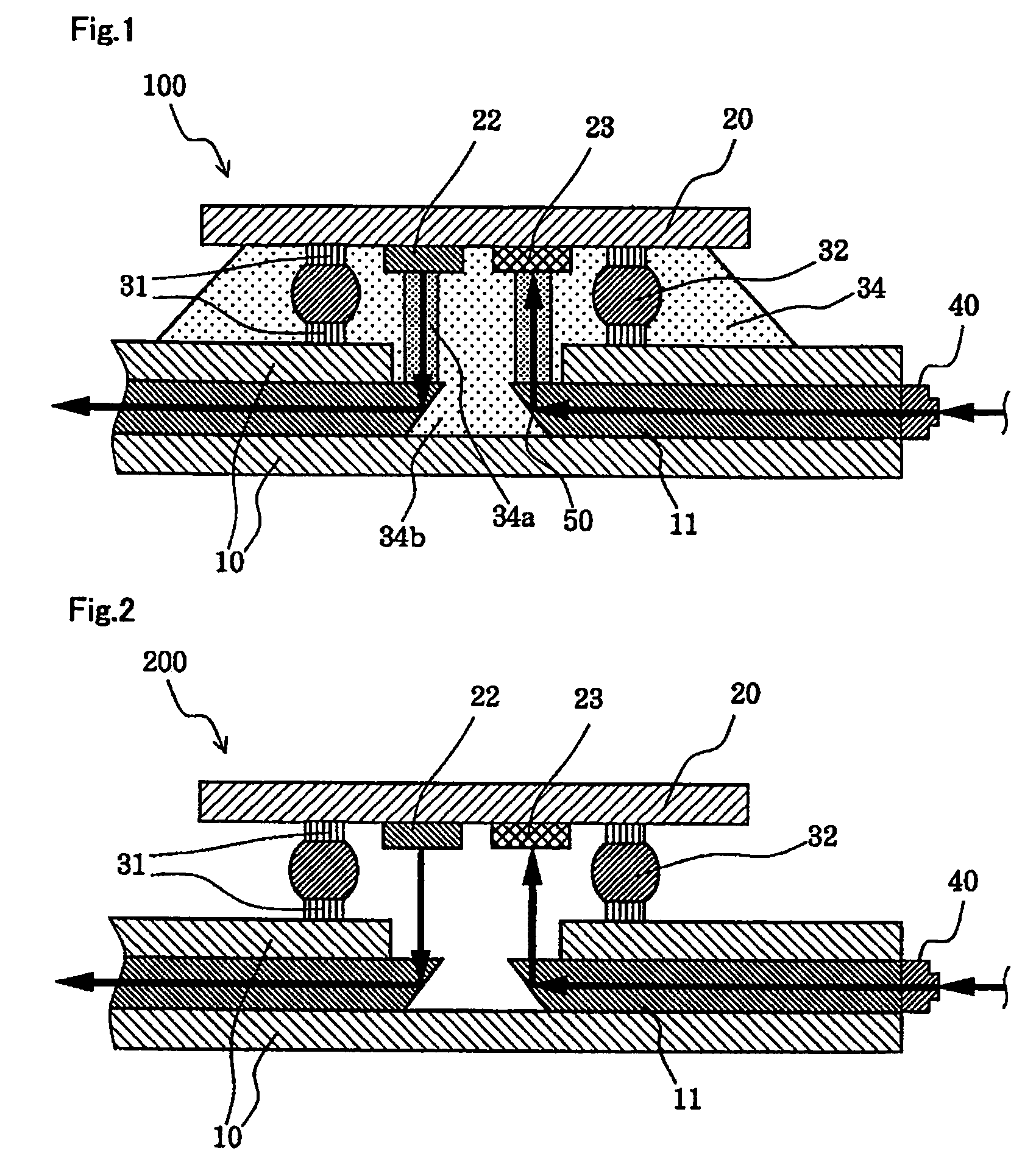Optical device and method for producing the same
a technology of optical devices and optical connections, applied in the direction of optical elements, instruments, optical waveguide light guides, etc., can solve the problems of inconvenient mounting of optical electronic integrated circuit boards, and inability to position techniques using microlenses or right-angle bending elements, etc., to achieve excellent optical connection characteristics and less optical loss
- Summary
- Abstract
- Description
- Claims
- Application Information
AI Technical Summary
Benefits of technology
Problems solved by technology
Method used
Image
Examples
example 1
[0065]First, the 45° mirrors 50 were formed in advance by dicing at positions of the optical waveguides 11 which correspond to the optical elements (VCSEL 22 and PD 23) mounted on the IC-chip mounting substrate 20 to optically connect the optical waveguides 11 and the VCSEL 22 and PD 23. Subsequently, a printed circuit board (FR4) 10 was bonded to the optical waveguides 11 with an epoxy adhesive to prepare the printed circuit board 10, which included the optical waveguides 11 as intermediate layers. A top hole was then formed using a drill machine at a position of the printed circuit board 10 which corresponds to the optical paths between the optical waveguides 11 and the VCSEL 22 and PD 23. The printed circuit board 10, which had an electrode pattern formed in advance, was mounted on the IC-chip mounting substrate 20, which had the VCSEL 22 and PD 23, by bonding the electrodes 31 using the solder balls 32 disposed under the substrate 20. The solder balls 32 were heated using a sold...
example 2
[0069]After the VCSEL 22 and PD 23 were mounted on the printed circuit board 10 as in Example 1, the space between the 45° mirrors 50 of the optical waveguides 11 and the VCSEL 22 and PD 23 was filled using a dispenser with an epoxy underfill material prepared by mixing a photocurable material and a thermosetting material.
[0070]The underfill material was partially cured for five minutes by both light with a wavelength of 850 nm emitted from the VCSEL 22 and light with a wavelength of 850 nm that was emitted from an external laser source to reach the PD 23 through the optical waveguide 11 to form an optical waveguide structure including the optical interconnects 34a as cores (core diameter=60 μm). The overall underfill material was then heated at 150° C. for 30 minutes to cure the overall resin layer 34.
[0071]The optical interconnects 34a thus prepared exhibited an optical loss of 1.0 dB, which indicates that the optical interconnects 34a had excellent light connection characteristic...
PUM
 Login to View More
Login to View More Abstract
Description
Claims
Application Information
 Login to View More
Login to View More - R&D
- Intellectual Property
- Life Sciences
- Materials
- Tech Scout
- Unparalleled Data Quality
- Higher Quality Content
- 60% Fewer Hallucinations
Browse by: Latest US Patents, China's latest patents, Technical Efficacy Thesaurus, Application Domain, Technology Topic, Popular Technical Reports.
© 2025 PatSnap. All rights reserved.Legal|Privacy policy|Modern Slavery Act Transparency Statement|Sitemap|About US| Contact US: help@patsnap.com



